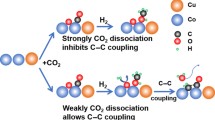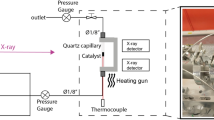Abstract
Ceria (CeO2) has been used in a number of catalytic processes, either as a support or promoter. For a better understanding of the factors that control the reactivity of ceria, we have used well-ordered CeO2(111) films and ceria nanoparticles supported on an ordered SiO2 film, as model catalysts. The systems were examined in the dehydrogenation of methanol to formaldehyde as a test reaction by using the techniques of infrared spectroscopy and temperature programmed desorption. The results revealed low-temperature reactivity (below 450 K) for supported ceria particles that is not present on ordered films, which show reactivity at 565 K. The results indicate that low-coordinated sites play an important role in the methanol reactivity on ceria.





Similar content being viewed by others
References
Bernal S, Kaspar J, Trovarelli A (1999) Recent progress in catalysis by ceria and related compounds—preface. Catal Today 50(2):173–443
Trovarelli A (1996) Catalytic properties of ceria and CeO2-containing materials. Catal Rev-Sci Eng 38(4):439–520
Jen HW et al (1999) Characterization of model automotive exhaust catalysts: Pd on ceria and ceria-zirconia supports. Catal Today 50(2):309–328
Wachs IE (2005) Recent conceptual advances in the catalysis science of mixed metal oxide catalytic materials. Catal Today 100(1–2):79–94
Sauer J, Dobler J (2004) Structure and reactivity of V2O5: bulk solid, nanosized clusters, species supported on silica and alumina, cluster cations and anions. Dalton Trans 19:3116–3121
Ganduglia-Pirovano MV et al (2010) Role of ceria in oxidative dehydrogenation on supported vanadia catalysts. J Am Chem Soc 132(7):2345–2349
Migani A et al (2010) Greatly facilitated oxygen vacancy formation in ceria nanocrystallites. Chem Commun 46(32):5936–5938
Migani A et al (2010) Dramatic reduction of the oxygen vacancy formation energy in ceria particles: a possible key to their remarkable reactivity at the nanoscale. J Mater Chem 20(46):10535–10546
Loschen C et al (2008) Density functional studies of model cerium oxide nanoparticles. Phys Chem Chem Phys 10(37):5730–5738
Wang AQ et al (2003) X-ray photoelectron spectroscopy study of electrodeposited nanostructured CeO2 films. J Vac Sci Technol B 21(3):1169–1175
Tsunekawa S, Fukuda T, Kasuya A (2000) X-ray photoelectron spectroscopy of monodisperse CeO2−x nanoparticles. Surf Sci 457(3):L437–L440
Qiu L et al (2006) Comparative XPS study of surface reduction for nanocrystalline and microcrystalline ceria powder. Appl Surf Sci 252(14):4931–4935
Baron M et al (2009) Interaction of gold with cerium oxide supports: CeO2(111) thin films vs CeOx nanoparticles. J Phys Chem C 113(15):6042–6049
Wu ZL et al (2010) Probing defect sites on CeO2 nanocrystals with well-defined surface planes by raman spectroscopy and O2 adsorption. Langmuir 26(21):16595–16606
Murugan B, Ramaswamy AV (2007) Defect-site promoted surface reorganization in nanocrystalline ceria for the low-temperature activation of ethylbenzene. J Am Chem Soc 129(11):3062
Zhou K et al (2005) Enhanced catalytic activity of ceria nanorods from well-defined reactive crystal planes. J Catal 229(1):206–212
Kuhlenbeck H, Shaikhutdinov S, Freund H-J (2013) Well-ordered transition metal oxide layers in model catalysis—a series of case studies. Chem Rev 113(6):3986–4034
Mullins DR, Radulovic PV, Overbury SH (1999) Ordered cerium oxide thin films grown on Ru(0001) and Ni(111). Surf Sci 429(1–3):186–198
Siokou A, Nix RM (1999) Interaction of methanol with well-defined ceria surfaces: reflection/absorption infrared spectroscopy, X-ray photoelectron spectroscopy, and temperature-programmed desorption study. J Phys Chem B 103(33):6984–6997
Mei D et al (2007) Methanol adsorption on the clean CeO2(111) surface: a density functional theory study. J Phys Chem C 111(28):10514–10522
Beste A et al (2008) Adsorption and dissociation of methanol on the fully oxidized and partially reduced (111) cerium oxide surface: dependence on the configuration of the cerium 4f electrons. Surf Sci 602(1):162–175
Badri A, Binet C, Lavalley J-C (1997) Use of methanol as an IR molecular probe to study the surface of polycrystalline ceria. J Chem Soc, Faraday Trans 93(6):1159–1168
Li C et al (1990) Spectroscopic identification of adsorbed species derived from adsorption and decomposition of formic acid, methanol, and formaldehyde on cerium oxide. J Catal 125(2):445–455
Binet C, Daturi M, Lavalley J-C (1999) IR study of polycrystalline ceria properties in oxidised and reduced states. Catal Today 50(2):207–225
Ferrizz RM et al (2001) Structure sensitivity of the reaction of methanol on ceria. Langmuir 17(8):2464–2470
Mullins DR, Robbins MD, Zhou J (2006) Adsorption and reaction of methanol on thin-film cerium oxide. Surf Sci 600(7):1547–1558
Löffler D et al (2010) Growth and structure of crystalline silica sheet on Ru(0001). Phys Rev Lett 105(14):146104
Yang B et al (2012) Thin silica films on Ru(0001): monolayer, bilayer and three-dimensional networks of [SiO4] tetrahedra. Phys Chem Chem Phys 14(32):11344–11351
Yang B et al (2013) Hydroxylation of metal-supported sheet-like silica films. J Phys Chem C 117(16):8336–8344
Wlodarczyk R et al (2013) The atomic structure of an ultrathin Fe-silicate film grown on a metal: a monolayer of clay? J Am Chem Soc 135(51):19222–19228
Abbott HL et al (2010) Relating methanol oxidation to the structure of ceria-supported vanadia monolayer catalysts. J Catal 272(1):82–91
Fronzi M et al (2009) Stability and morphology of cerium oxide surfaces in an oxidizing environment: a first-principles investigation. J Chem Phys 131(10):104701–104716
Acknowledgments
We acknowledge the support from the COST Action CM1104 “Reducible oxide chemistry, structure and functions”.
Author information
Authors and Affiliations
Corresponding author
Rights and permissions
About this article
Cite this article
Uhlrich, J.J., Yang, B. & Shaikhutdinov, S. Methanol Reactivity on Silica-Supported Ceria Nanoparticles. Top Catal 57, 1229–1235 (2014). https://doi.org/10.1007/s11244-014-0296-2
Published:
Issue Date:
DOI: https://doi.org/10.1007/s11244-014-0296-2




